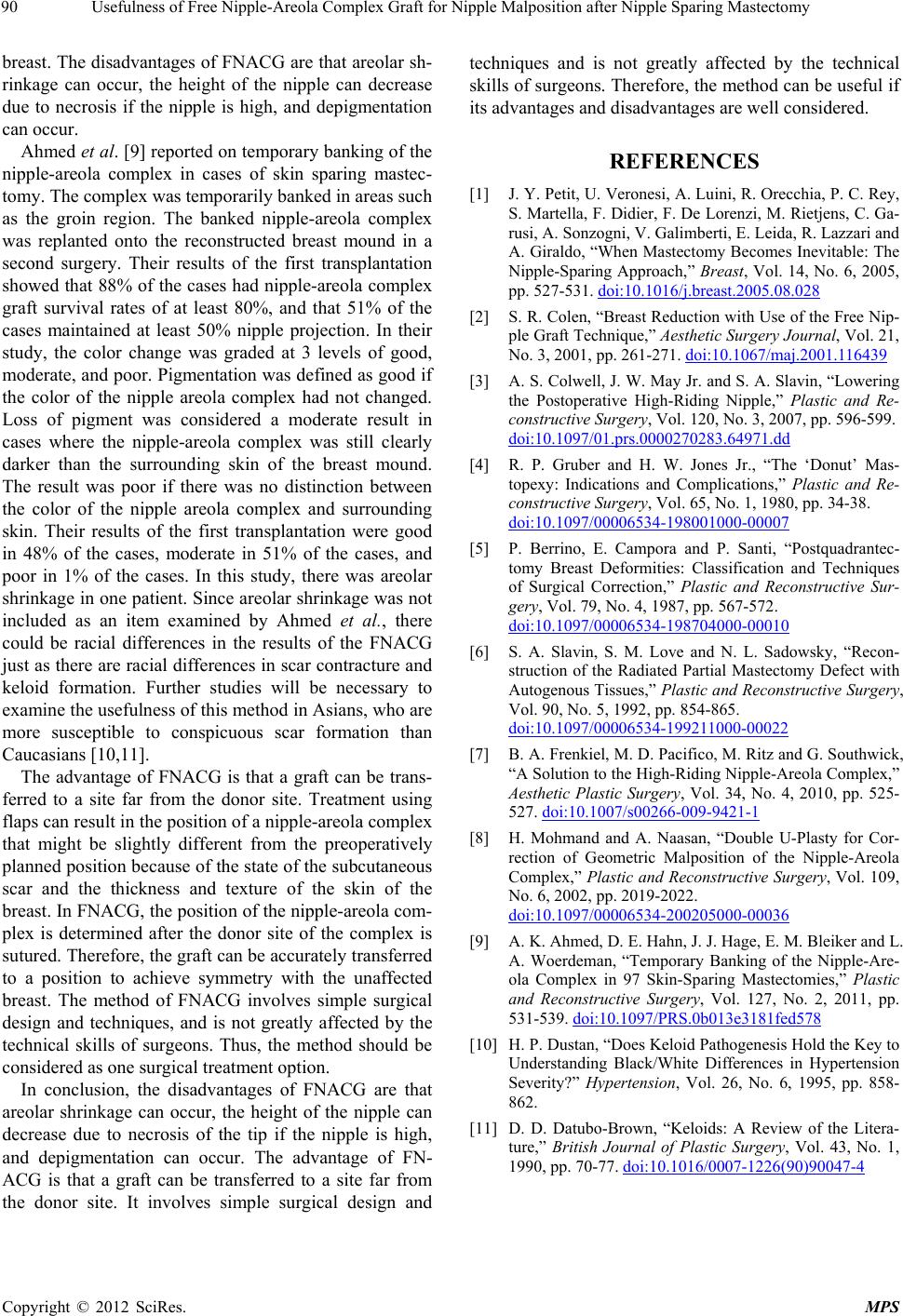
Usefulness of Free Nipple-Areola Complex Graft for Nipple Malposition after Nipple Sparing Mastectomy
Copyright © 2012 SciRes. MPS
90
breast. The disadvantages of FNACG are that areolar sh-
rinkage can occur, the height of the nipple can decrease
due to necrosis if the nipple is high, and depigmentation
can occur.
Ahmed et al. [9] reported on temporary banking of the
nipple-areola complex in cases of skin sparing mastec-
tomy. The complex was temporarily banked in areas such
as the groin region. The banked nipple-areola complex
was replanted onto the reconstructed breast mound in a
second surgery. Their results of the first transplantation
showed that 88% of the cases had nipple-areola complex
graft survival rates of at least 80%, and that 51% of the
cases maintained at least 50% nipple projection. In their
study, the color change was graded at 3 levels of good,
moderate, and poor. Pig mentation was defined as good if
the color of the nipple areola complex had not changed.
Loss of pigment was considered a moderate result in
cases where the nipple-areola complex was still clearly
darker than the surrounding skin of the breast mound.
The result was poor if there was no distinction between
the color of the nipple areola complex and surrounding
skin. Their results of the first transplantation were good
in 48% of the cases, moderate in 51% of the cases, and
poor in 1% of the cases. In this study, there was areolar
shrinkage in one patient. Since areolar shrinkage was not
included as an item examined by Ahmed et al., there
could be racial differences in the results of the FNACG
just as there are racial differences in scar contracture and
keloid formation. Further studies will be necessary to
examine the usefulness of this method in Asians, who are
more susceptible to conspicuous scar formation than
Caucasians [10,11].
The advantage of FNACG is that a graft can be trans-
ferred to a site far from the donor site. Treatment using
flaps can result in th e position o f a nipp le-areola co mplex
that might be slightly different from the preoperatively
planned position because of the state of the subcutaneous
scar and the thickness and texture of the skin of the
breast. In FNACG, the position of the nipple-areo la com-
plex is determined after the donor site of the complex is
sutured. Th erefo r e, th e graf t can be accurately transferred
to a position to achieve symmetry with the unaffected
breast. The method of FNACG involves simple surgical
design and techniques, and is not greatly affected by the
technical skills of surgeons. Thus, the method should be
considered as one surgical treatment option.
In conclusion, the disadvantages of FNACG are that
areolar shrinkage can occur, the height of the nipple can
decrease due to necrosis of the tip if the nipple is high,
and depigmentation can occur. The advantage of FN-
ACG is that a graft can be transferred to a site far from
the donor site. It involves simple surgical design and
techniques and is not greatly affected by the technical
skills of surgeons. Therefore, the method can be useful if
its advantages and disadvantages are well considered.
REFERENCES
[1] J. Y. Petit, U. Veronesi, A. Luini, R. Orecchia, P. C. Rey,
S. Martella, F. Didier, F. De Lorenzi, M. Rietjens, C. Ga-
rusi, A. Sonzogni, V. Galimberti, E. Leida, R. Lazzari and
A. Giraldo, “When Mastectomy Becomes Inevitable: The
Nipple-Sparing Approach,” Breast, Vol. 14, No. 6, 2005,
pp. 527-531. doi:10.1016/j.breast.2005.08.028
[2] S. R. Colen, “Breast Reduction with Use of the Free Nip-
ple Graft Technique,” Aesthetic Surgery Journal, Vol. 21,
No. 3, 2001, pp. 261-271. doi:10.1067/maj.2001.116439
[3] A. S. Colwell, J. W. May Jr. and S. A. Slavin, “Lowering
the Postoperative High-Riding Nipple,” Plastic and Re-
constructive Surgery, Vol. 120, No. 3, 2007, pp. 596-599.
doi:10.1097/01.prs.0000270283.64971.dd
[4] R. P. Gruber and H. W. Jones Jr., “The ‘Donut’ Mas-
topexy: Indications and Complications,” Plastic and Re-
constructive Surgery, Vol. 65, No. 1, 1980, pp. 34-38.
doi:10.1097/00006534-198001000-00007
[5] P. Berrino, E. Campora and P. Santi, “Postquadrantec-
tomy Breast Deformities: Classification and Techniques
of Surgical Correction,” Plastic and Reconstructive Sur-
gery, Vol. 79, No. 4, 1987, pp. 567-572.
doi:10.1097/00006534-198704000-00010
[6] S. A. Slavin, S. M. Love and N. L. Sadowsky, “Recon-
struction of the Radiated Partial Mastectomy Defect with
Autogenous Tissues,” Plastic and Reconstructive Surgery,
Vol. 90, No. 5, 1992, pp. 854-865.
doi:10.1097/00006534-199211000-00022
[7] B. A. Frenkiel, M. D. Pacifico, M. Ritz and G. Southwick,
“A Solution to the High-Riding Nipple-Areola Complex,”
Aesthetic Plastic Surgery, Vol. 34, No. 4, 2010, pp. 525-
527. doi:10.1007/s00266-009-9421-1
[8] H. Mohmand and A. Naasan, “Double U-Plasty for Cor-
rection of Geometric Malposition of the Nipple-Areola
Complex,” Plastic and Reconstructive Surgery, Vol. 109,
No. 6, 2002, pp. 2019-2022.
doi:10.1097/00006534-200205000-00036
[9] A. K. Ahmed, D. E. Hahn, J. J. Hage, E. M. Bleiker and L.
A. Woerdeman, “Temporary Banking of the Nipple-Are-
ola Complex in 97 Skin-Sparing Mastectomies,” Plastic
and Reconstructive Surgery, Vol. 127, No. 2, 2011, pp.
531-539. doi:10.1097/PRS.0b013e3181fed578
[10] H. P. Dustan, “Does Keloid Pathogenesis Hold the Key to
Understanding Black/White Differences in Hypertension
Severity?” Hypertension, Vol. 26, No. 6, 1995, pp. 858-
862.
[11] D. D. Datubo-Brown, “Keloids: A Review of the Litera-
ture,” British Journal of Plastic Surgery, Vol. 43, No. 1,
1990, pp. 70-77. doi:10.1016/0007-1226(90)90047-4